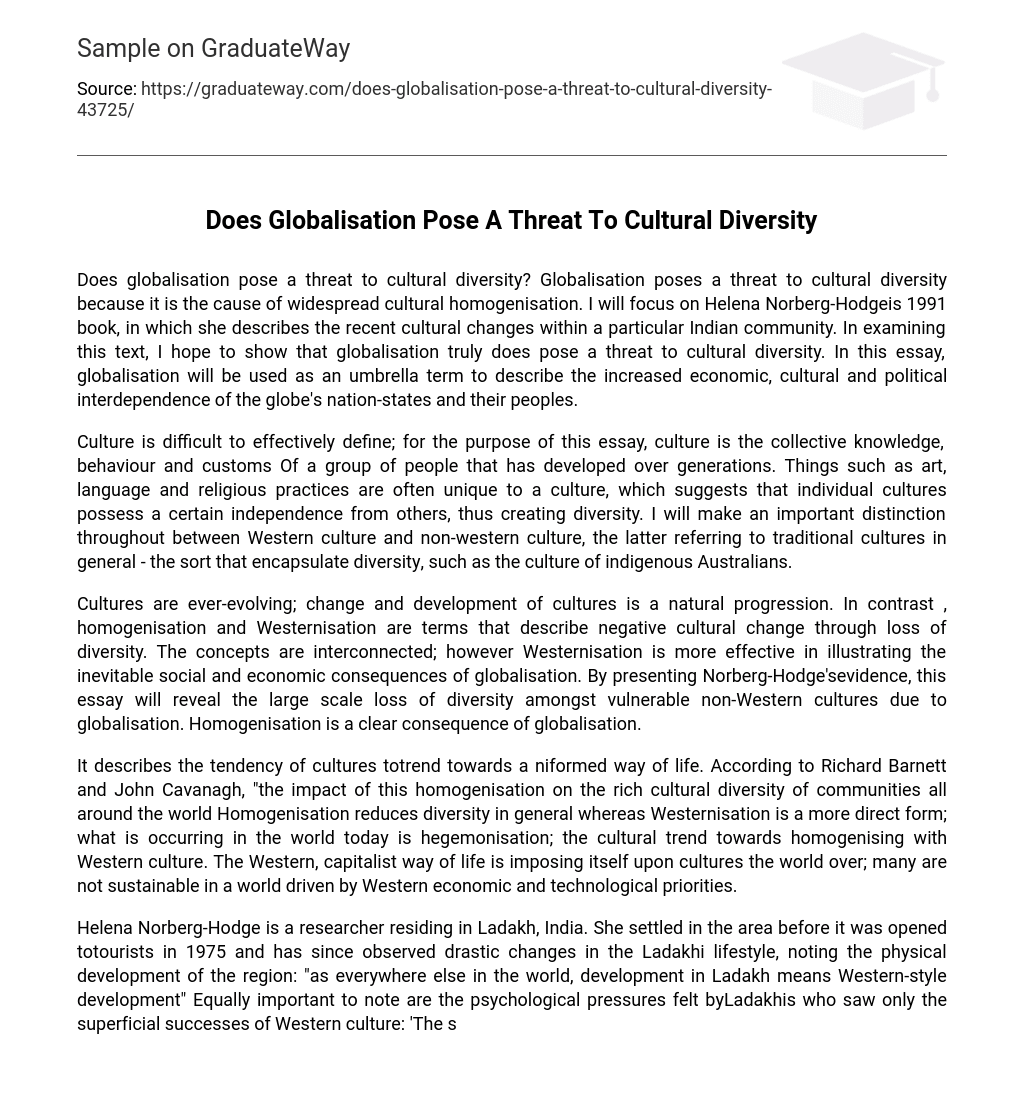Globalisation is a risk to cultural diversity as it encourages widespread cultural homogeneity. The focal point of my research is Helena Norberg-Hodgeis’ 1991 publication, which investigates recent cultural transformations within a particular Indian community. By analyzing this text, I aim to illustrate that globalisation poses a significant threat to cultural diversity. For the scope of this essay, globalisation will be defined as the augmentation of economic, cultural, and political interconnections between nations and their people.
The collective knowledge, behavior, and customs that develop within a group of people over time is referred to as culture. It includes elements like art, language, and religious practices that contribute to cultural diversity. This essay focuses on comparing Western culture with non-Western culture, specifically emphasizing traditional cultures such as indigenous Australians known for their rich heritage.
The natural progression of cultures involves constant evolution, change, and development. However, negative cultural changes resulting in the loss of diversity can be referred to as homogenisation and Westernisation. These concepts are interconnected, but Westernisation exemplifies the social and economic consequences of globalisation more effectively. By presenting Norberg-Hodge’s evidence, this essay aims to demonstrate the significant loss of diversity in vulnerable non-Western cultures caused by globalisation, ultimately resulting in homogenisation.
The concept of cultural homogenisation refers to the tendency of cultures to move towards a uniform way of life. Richard Barnett and John Cavanagh argue that this homogenisation is impacting the diverse cultural communities across the globe. Homogenisation diminishes diversity in general, while Westernisation is a more direct form of this process. Currently, what is happening worldwide can be described as hegemonisation, which is the cultural trend towards adopting Western culture. The Western capitalist lifestyle is imposing itself on cultures globally, which poses challenges for those cultures that are not compatible with Western economic and technological priorities.
Helena Norberg-Hodge, a resident researcher in Ladakh, India, has witnessed significant changes in the Ladakhi lifestyle since settling in the area prior to its opening to tourists in 1975. She has observed the physical development of the region, which follows a Western-style development, similar to everywhere else in the world. Additionally, she acknowledges the psychological pressures experienced by Ladakhis who only see the surface-level successes of Western culture, leading to feelings of inferiority. This process of Westernization poses a threat to cultural diversity. Professor Ali Mazrui from Binghamton University refers to this phenomenon as “hegemonization,” highlighting that the Western world has become a dominant influence. As a result, by the twenty-first century, people are dressing more similarly worldwide compared to the end of the nineteenth century, with the Western dress code overwhelmingly becoming globalized.
Mazrui’s demonstration of both terms clarifies the difference between them and highlights how Western hegemony can jeopardize cultural diversity, an inherent aspect of globalization. The impact of globalization on Westernization leads to numerous social and economic challenges. Education, politics, technology, and the thriving global tourism industry contribute to the erosion of cultural significance.
Nordberg-Hodge introduces the reader to individuals whose lives have undergone significant transformations, creating a relatable and impactful portrait. The allure of a prosperous and carefree existence generated by Western tourism, television, and technology entices non-western cultures, who are unaware of the negative aspects of Western culture. These individuals fail to perceive the social and psychological consequences such as stress, loneliness, and the fear of aging.
Both Western and traditional cultures have their limitations and imperfections. However, Western culture has a strong influence on people, leading them to abandon their current way of life for an unknown future. Traditional cultures, like Ladakhi culture, are often seen as primitive and impoverished by Western views. Despite this, traditional cultures possess a deep understanding of their own limitations and imperfections.
Western tourists fail to recognize the deep value of Ladakhi culture, dismissing it with uneducated comparisons to their own. The psychological, social, and spiritual wealth of the Ladakhis goes unnoticed, as it is overshadowed by the glossy images and descriptions in tourist brochures and luxurious hotel accommodations. This lack of understanding and connection between Western and non-western cultures leads to the dominance of Western culture in various regions and societies, due to its perceived aesthetic appeal. However, this dominance also leads to social and economic imbalances, even in small towns.





